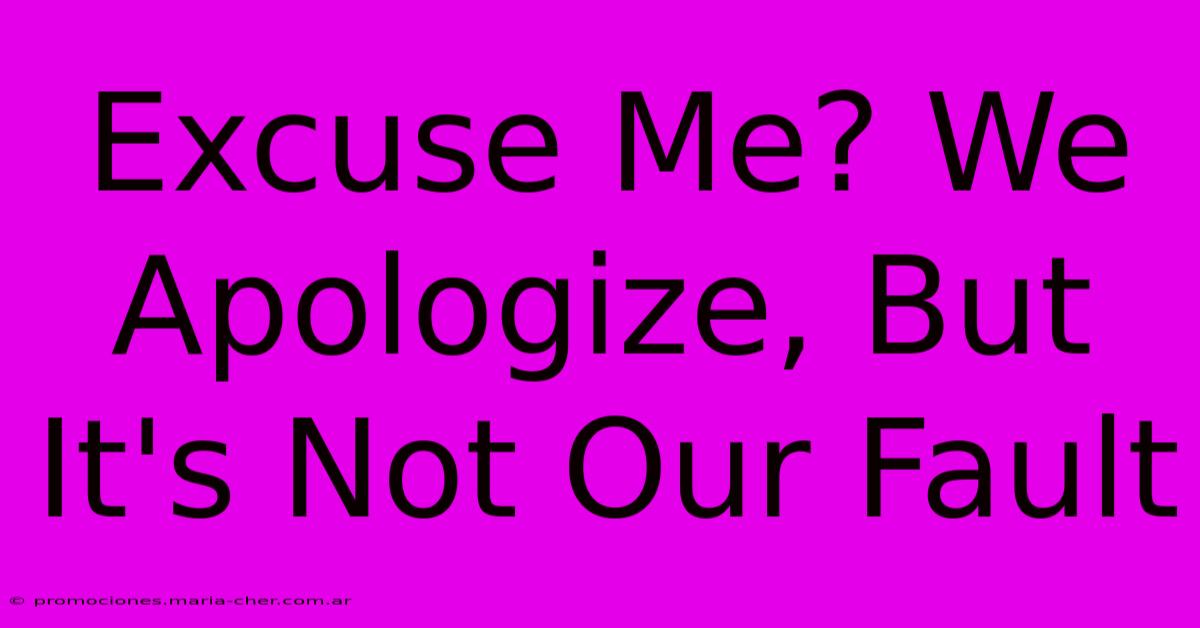Excuse Me? We Apologize, But It's Not Our Fault

Table of Contents
Excuse Me? We Apologize, But It's Not Our Fault: Navigating Apology When You're Not at Fault
It's a frustrating situation: something goes wrong, a customer is upset, and you're expected to apologize. But what happens when the problem isn't your fault? Knowing how to navigate these tricky situations is crucial for maintaining positive customer relationships and protecting your business reputation. This article explores how to effectively apologize without accepting blame when it's unwarranted.
The Importance of a Measured Response
While you may not be responsible, a customer's negative experience is still real. Ignoring their concerns or responding defensively will likely escalate the situation. A measured response that acknowledges their frustration, even without accepting blame, can dramatically improve the outcome. Empathy is key.
Understanding the Customer's Perspective
Before crafting your response, take a moment to understand the customer's perspective. What happened from their point of view? What are their unmet expectations? Even if you’re not at fault, acknowledging their feelings can go a long way. Phrases like, "I understand your frustration," or "I can see why you're upset," show empathy without admitting guilt.
Crafting Your Apology: Expressing Sympathy Without Accepting Blame
The art lies in expressing sympathy for the inconvenience without accepting responsibility for the cause. Here’s how:
1. Acknowledge the Problem:
Begin by directly acknowledging the problem the customer experienced. For example: "I understand you're having trouble with [product/service/situation]," or "I'm sorry you encountered this difficulty."
2. Express Empathy:
Follow up by expressing your understanding of their frustration. For example: "I can see how frustrating this must be," or "I'm sorry you're having such a negative experience."
3. Clearly State Your Lack of Direct Responsibility (Without Being Defensive):
This is the crucial part. You need to explain why the issue isn't your direct fault, without sounding defensive or blaming the customer. For example:
- "While this issue is outside of our direct control, we understand it's still impacting your experience."
- "Unfortunately, this was due to [external factor, e.g., a supplier issue, a third-party service outage]. We're working diligently to resolve the situation."
- "Our systems are currently experiencing [technical difficulty] which is beyond our immediate control, but we are working to restore service as quickly as possible."
4. Offer a Solution (Where Possible):
Even if you're not at fault, offering a solution demonstrates good customer service. This might include:
- Providing alternative solutions or workarounds.
- Offering a refund or discount.
- Providing a timeline for resolution.
- Offering proactive communication updates.
5. Thank the Customer for Their Patience and Understanding:
End the interaction by thanking the customer for their patience and understanding. This shows appreciation for their time and helps to de-escalate the situation.
Example Scenario & Response:
Scenario: A customer is upset because their package arrived late due to a national shipping strike.
Effective Response: "I understand your frustration with the delayed delivery of your package. I sincerely apologize for the inconvenience this has caused. Unfortunately, this delay is due to the ongoing national shipping strike, which is impacting deliveries across the country. We are monitoring the situation closely and working with the shipping carrier to get your package to you as soon as possible. We expect deliveries to resume within [ timeframe]. In the meantime, I've issued a full refund for the shipping costs."
Key Takeaways
Handling situations where you're not at fault requires a delicate balance of empathy, clear communication, and problem-solving. By following these steps, you can diffuse tense situations, maintain positive customer relationships, and protect your business reputation. Remember, focusing on the customer experience and finding solutions – even if the problem is external – is paramount. Prioritizing open communication and proactive updates can turn a negative experience into an opportunity to strengthen customer loyalty.

Thank you for visiting our website wich cover about Excuse Me? We Apologize, But It's Not Our Fault. We hope the information provided has been useful to you. Feel free to contact us if you have any questions or need further assistance. See you next time and dont miss to bookmark.
Featured Posts
-
Wholesale Wonderland Babys Breath For A Floral Fantasy Come True
Feb 08, 2025
-
Unleash The True Potential Of Your Camera The Step By Step Formula To Enhance Image Quality
Feb 08, 2025
-
Unveil The Secret Of Everlasting Beauty Discover Discount Dried Flowers That Defy The Seasons
Feb 08, 2025
-
Beyond Basics Explore The Hidden Potential Of Floral Tape For Floral Masterpieces
Feb 08, 2025
-
Defy Winter Blues Get Your Roses Blooming In Any Season
Feb 08, 2025
